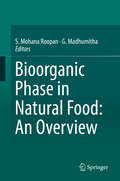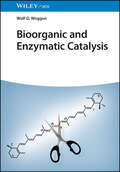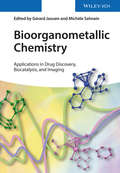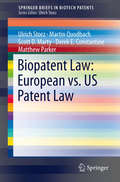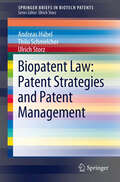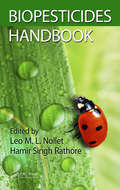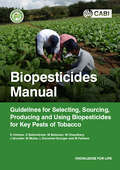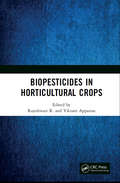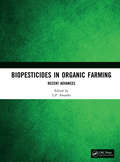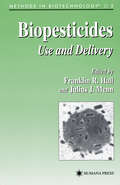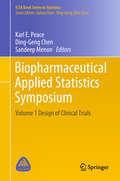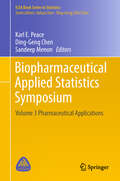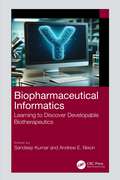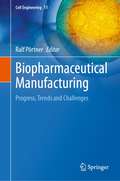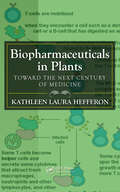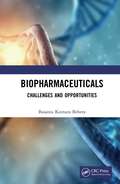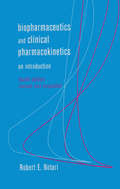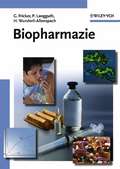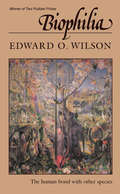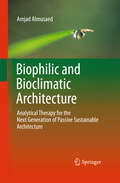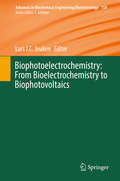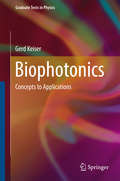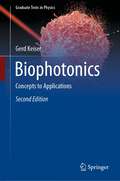- Table View
- List View
Bioorganic Phase in Natural Food: An Overview
by S. Mohana Roopan G. MadhumithaThe focus of this singular work is to discuss the role and importance of bioorganic phase in food products-providing the first major reference source for researchers looking to understand all aspects of the isolation, extraction and application of this major element in natural foods. From the identifying features to its applications through biotechnology and nanobiotechnology, this book covers all of the important aspects of bioorganic phase and points to future uses and methods. With chapters focusing on phase extraction and application, food product synthesis and nanoparticle application, Bioorganic Phase in Natural Food: An Overview covers both conventional and non-conventional approaches for the extraction of bioorganic phase from various food sources. Toxicity studies in nanoparticles are presented, and the vital role played by bioorganic phase toward nanoparticles synthesis is outlined in full. For any researcher looking for complete coverage of all main aspects of bioorganic phase in foods, this work provides a comprehensive and well-researched view of this important subject. .
Bioorganic and Enzymatic Catalysis
by Wolf-D. WoggonBioorganic and Enzymatic Catalysis Direct comparison of enzymatic reactions and corresponding catalytic transformations in the laboratory Bioorganic and Enzymatic Catalysis covers the most important enzymatic reactions and related catalytic bioorganic reactions using a new approach: Each enzymatic reaction type is compared with organocatalytic, organometallic and other alternative reactions, allowing the reader to understand catalytic reactions in a much-integrated way. For example, in a chapter that describes aldolases corresponding reactions using catalytic antibodies, organocatalytic reagents and metal complexes are discussed. Written by a well-known expert in the field with more than 30 years of experience in organic and bioorganic chemistry, Bioorganic and Enzymatic Catalysis covers sample topics such as: Enzymatic C-C bond formation using aldolases Claisen-type C-C bond formation involving fatty acid synthases and polyketide synthases Biomimetic cyclisations involving carbenium ions Enzymatic oxidation and C-H activation Dioxygenases and oxidoreductases With its unique approach, Bioorganic and Enzymatic Catalysis is a valuable source of information for professionals and researchers in academia and industry as well as graduate and PhD students working in the fields of organic chemistry, biochemistry, and life sciences.
Bioorganometallic Chemistry
by Mich Le Salmain Gérard JaouenAn up-to-date reference reflecting the significant advances and important breakthroughs made in this emerging discipline over the last decade.As such, the book provides an overview of the latest developments and future trends in the field, focusing on such applications as the development of potentially active organometallic drugs against incurable diseases, as well as in such areas as catalysis, energy, analytical chemistry, and imaging. The renowned editor, who established the term "bioorganometallics", and his international team of experts have put together a valuable resource for researchers in organometallic, inorganic, medicinal, and biochemistry.
Biopatent Law: European Patent Law Vs. Us Patent Law (SpringerBriefs in Biotech Patents)
by Matthew Parker Ulrich Storz Martin Quodbach Scott D. Marty Derek E. ConstantineSpringerBriefs in Biotech Patents presents timely reports on intellectual properties (IP) issues and patent aspects in the field of biotechnology. This volume focus on particular aspects of the US patent law, which can have tremendous differences compared to the European law. This includes questions of biopatent prosecution, novelty, inventive step, written disclosure and sufficiency of enablement as well as questions of law enforcement of biotech patents.
Biopatent Law: Patent Strategies And Patent Management (SpringerBriefs in Biotech Patents)
by Ulrich Storz Andreas Hübel Thilo SchmelcherPatents protecting biotechnological invention are becoming ever more important. Because biotechnology has many differences with respect to other technologies, lessons learned in other fields of technology cannot simply be transferred to adopt a suitable strategy for dealing with biotechnology inventions. In this volume, general aspects of biopatent law will be discussed. This involves questions of patentability, including ethical issues and issues of technicality, as well as questions of patent exhaustion in cases were reproducible subject matter, like cells or seeds, is protected. Moreover, active and passive patent strategies are addressed. Further, insight will be given into patent lifetime management and additional protective measures, like supplementary protection certificates and data exclusivity. Here, strategies are discussed how market exclusivity can be extended as long as possible, which is particularly important for biopharmaceutical drugs, which create high R&D costs.
Biopesticides Handbook
by Hamir Singh Rathore Leo M. L. NolletThe need to feed an ever-growing global population combined with increasing demand for sustainable agricultural practices has generated a significant rise in demand for biopesticides. By responding concurrently to the interests of farming, forestry, and industrial sectors, biopesticides offer a considerable potential for utilization in sustainable
Biopesticides Handbook
by Leo M.L. Nollet Showkat Rasool MirBiopesticides have a great influence in sustainable agriculture, and their use in commercial farming ensures environmental protection, qualitative products, and effective use of resources. The second edition of Biopesticides Handbook is fully updated and includes five new chapters on microbial, biochemical, and RNAi pesticides. It details the benefits of biopesticides along the food chain, offering a full spectrum of the range of organisms and organic products that may be used in the biological control of pests. It discusses the uses and abuses of biopesticides, their positive and negative consequences, as well as more recent advances and the best mode of action to improve environmental safety. FEATURES Thoroughly updated, this edition explores not only the benefits but also all aspects of biopesticides Includes new chapters on the uses of biochemical and microbial pesticides and plant-incorporated protectants Discusses the new field of RNAi pesticides Provides information on insect growth regulators and allelochemicals Introduces a new chapter on the uses of biopesticides in food and medicinal crops This book is intended for professionals, researchers, academics, and postgraduate students with experience in fields such as chemistry, biochemistry, environmental sciences, ecology, and agriculture, as well as those invested in the supply chain of agricultural products, such as farmers, growers, and other stakeholders.
Biopesticides Manual: Guidelines for Selecting, Sourcing, Producing and Using Biopesticides for Key Pests of Tobacco
by Dirk Babendreier Keith A Holmes Melanie Bateman Malvika Chaudhary Julien Grunder Margaret Mulaa Léna Durocher-Granger Muhammad FaheemThe Biopesticides Manual provides information resources and technical advice in order to support the deployment of biopesticides. It is a one-stop-shop to address the information needs of the key groups who are responsible for selecting, sourcing and using biopesticides in the tobacco production system. Biopesticides are a key component of integrated pest management (IPM) in tobacco. IPM seeks to reduce the risk of harm to people and the environment. When used in conjunction with good crop management, biopesticides can help to keep pest levels under control, reducing the need to apply conventional pesticides.
Biopesticides in Horticultural Crops
by Rajeshwari R. Vikram AppannaThis book is a compendium of information related to innovations, commercialization and registration of biopesticides, recent advances in mass production, formulation, extension of shelf life, delivery systems of antagonists and entomopathogens and synergistic and antagonistic response of biopesticides with agrochemicals. The information on all the important laboratory protocols and techniques in isolation, identification, selection, culturing, mass production, formulation, enhancement of shelf life and biosafety issues of bioinoculants used as biopesticides in horticulture crops have been included for the benefit of research scientists, teachers, research scholars and students working in the field of biopesticides.Note: T&F does not sell or distribute the hardback in India, Pakistan, Nepal, Bhutan, Bangladesh and Sri Lanka.
Biopesticides in Organic Farming: Recent Advances
by L. P. AwasthiThe book entitled "Biopesticides in Organic Farming : Recent Advances", describes critically reviewed, key aspects of organic farming and provides a unique and timely science-based resource for researchers, teachers, extension workers, students, primary producers and others around the world. This book is intended to be a unique and indispensable resource that offers a diverse range of valuable information and perspectives on biopesticides in organic agriculture. It has chapters on each and every aspect related with biopesticides in organic farming which are compiled by researchers and eminent professors at various universities across the globe. The wide spectrum information in various chapters with the addition of the terms related to organic farming and concept statements is presented in very concise manner. Features: This book is designed, as per course curriculum of different universities offering courses on Organic Farming, for undergraduate and post graduate students, researchers, university professors and extension workers. The first section provides, Overview of organic farming with special reference to biopesticides followed by the Principles of the applications of biopesticides in organic farming, Impact of Environmental factors on biopesticides in organic farming, Pesticides Exposure Impacts on Health and Need of Biopesticides in Organic Farming, and Role of nutrients in the management of crop diseases through biopesticides. The next section deals with the management of various crop diseases through biopesticides of bacterial, fungal, viral, and Insect sex hormone, Natural enemies and Integrated Pest Management, Biotechnological Trends in Insect Pests Control Strategy, Challenges in the popularization of Biopesticides in organic farming, Certification process and standards of organic farming and Marketing and export potential of organic Products. Information presented in an accessible way for students, professors, researchers, business innovators and entrepreneurs, management professionals and practitioners.
Biopesticides: Use and Delivery (Methods in Biotechnology #5)
by Franklin R. Hall Julius J. MennA definitive guide to the development, application, and use of biopesticides as a complementary or alternative treatment to chemical pesticides. Biopesticides: Use and Delivery brings together for the first time all the latest advances in the control of insects, plant diseases, and weeds with biopesticides. Coverage extends from the science and technology of biofungicides, bioinsecticides, and bioherbicides to detailed management protocols. The many leading experts writing here review their development, mode of action, production, delivery systems (formulations), and future market prospects. In addition, experts from both government and industry discuss current registration requirements, including time frame and costs of registration, and compare these with the registration requirements for conventional pesticides.
Biopharmaceutical Applied Statistics Symposium: Volume 3 Pharmaceutical Applications (ICSA Book Series in Statistics)
by Ding-Geng Chen Karl E. Peace Sandeep MenonThis BASS book Series publishes selected high-quality papers reflecting recent advances in the design and biostatistical analysis of biopharmaceutical experiments – particularly biopharmaceutical clinical trials. The papers were selected from invited presentations at the Biopharmaceutical Applied Statistics Symposium (BASS), which was founded by the first Editor in 1994 and has since become the premier international conference in biopharmaceutical statistics. The primary aims of the BASS are: 1) to raise funding to support graduate students in biostatistics programs, and 2) to provide an opportunity for professionals engaged in pharmaceutical drug research and development to share insights into solving the problems they encounter.The BASS book series is initially divided into three volumes addressing: 1) Design of Clinical Trials; 2) Biostatistical Analysis of Clinical Trials; and 3) Pharmaceutical Applications. This book is the first of the 3-volume book series. The topics covered include: A Statistical Approach to Clinical Trial Simulations, Comparison of Statistical Analysis Methods Using Modeling and Simulation for Optimal Protocol Design, Adaptive Trial Design in Clinical Research, Best Practices and Recommendations for Trial Simulations in the Context of Designing Adaptive Clinical Trials, Designing and Analyzing Recurrent Event Data Trials, Bayesian Methodologies for Response-Adaptive Allocation, Addressing High Placebo Response in Neuroscience Clinical Trials, Phase I Cancer Clinical Trial Design: Single and Combination Agents, Sample Size and Power for the Mixed Linear Model, Crossover Designs in Clinical Trials, Data Monitoring: Structure for Clinical Trials and Sequential Monitoring Procedures, Design and Data Analysis for Multiregional Clinical Trials – Theory and Practice, Adaptive Group-Sequential Multi-regional Outcome Studies in Vaccines, Development and Validation of Patient-reported Outcomes, Interim Analysis of Survival Trials: Group Sequential Analyses, and Conditional Power – A Non-proportional Hazards Perspective.
Biopharmaceutical Applied Statistics Symposium: Volume 3 Pharmaceutical Applications (ICSA Book Series in Statistics)
by Ding-Geng Chen Karl E. Peace Sandeep MenonThis BASS book Series publishes selected high-quality papers reflecting recent advances in the design and biostatistical analysis of biopharmaceutical experiments – particularly biopharmaceutical clinical trials. The papers were selected from invited presentations at the Biopharmaceutical Applied Statistics Symposium (BASS), which was founded by the first Editor in 1994 and has since become the premier international conference in biopharmaceutical statistics. The primary aims of the BASS are: 1) to raise funding to support graduate students in biostatistics programs, and 2) to provide an opportunity for professionals engaged in pharmaceutical drug research and development to share insights into solving the problems they encounter.The BASS book series is initially divided into three volumes addressing: 1) Design of Clinical Trials; 2) Biostatistical Analysis of Clinical Trials; and 3) Pharmaceutical Applications. This book is the second of the 3-volume book series. The topics covered include: Statistical Approaches to the Meta-analysis of Randomized Clinical Trials, Collaborative Targeted Maximum Likelihood Estimation to Assess Causal Effects in Observational Studies, Generalized Tests in Clinical Trials, Discrete Time-to-event and Score-based Methods with Application to Composite Endpoint for Assessing Evidence of Disease Activity-Free , Imputing Missing Data Using a Surrogate Biomarker: Analyzing the Incidence of Endometrial Hyperplasia, Selected Statistical Issues in Patient-reported Outcomes, Network Meta-analysis, Detecting Safety Signals Among Adverse Events in Clinical Trials, Applied Meta-analysis Using R, Treatment of Missing Data in Comparative Effectiveness Research, Causal Estimands: A Common Language for Missing Data, Bayesian Subgroup Analysis with Examples, Statistical Methods in Diagnostic Devices, A Question-Based Approach to the Analysis of Safety Data, Analysis of Two-stage Adaptive Seamless Trial Design, and Multiplicity Problems in Clinical Trials – A Regulatory Perspective.
Biopharmaceutical Applied Statistics Symposium: Volume 3 Pharmaceutical Applications (ICSA Book Series in Statistics)
by Ding-Geng Chen Karl E. Peace Sandeep MenonThis BASS book Series publishes selected high-quality papers reflecting recent advances in the design and biostatistical analysis of biopharmaceutical experiments – particularly biopharmaceutical clinical trials. The papers were selected from invited presentations at the Biopharmaceutical Applied Statistics Symposium (BASS), which was founded by the first Editor in 1994 and has since become the premier international conference in biopharmaceutical statistics. The primary aims of the BASS are: 1) to raise funding to support graduate students in biostatistics programs, and 2) to provide an opportunity for professionals engaged in pharmaceutical drug research and development to share insights into solving the problems they encounter.The BASS book series is initially divided into three volumes addressing: 1) Design of Clinical Trials; 2) Biostatistical Analysis of Clinical Trials; and 3) Pharmaceutical Applications. This book is the third of the 3-volume book series. The topics covered include: Targeted Learning of Optimal Individualized Treatment Rules under Cost Constraints, Uses of Mixture Normal Distribution in Genomics and Otherwise, Personalized Medicine – Design Considerations, Adaptive Biomarker Subpopulation and Tumor Type Selection in Phase III Oncology Trials, High Dimensional Data in Genomics; Synergy or Additivity - The Importance of Defining the Primary Endpoint, Full Bayesian Adaptive Dose Finding Using Toxicity Probability Interval (TPI), Alpha-recycling for the Analyses of Primary and Secondary Endpoints of Clinical Trials, Expanded Interpretations of Results of Carcinogenicity Studies of Pharmaceuticals, Randomized Clinical Trials for Orphan Drug Development, Mediation Modeling in Randomized Trials with Non-normal Outcome Variables, Statistical Considerations in Using Images in Clinical Trials, Interesting Applications over 30 Years of Consulting, Uncovering Fraud, Misconduct and Other Data Quality Issues in Clinical Trials, Development and Evaluation of High Dimensional Prognostic Models, and Design and Analysis of Biosimilar Studies.
Biopharmaceutical Informatics: Learning to Discover Developable Biotherapeutics
by Sandeep Kumar Andrew E. NixonDespite the phenomenal clinical success of antibody-based biopharmaceuticals in recent years, discovery and development of these novel biomedicines remains a costly, time-consuming, and risky endeavor with low probability of success. To bring better biomedicines to patients faster, we have come up with a strategic vision of Biopharmaceutical Informatics which calls for syncretic use of computation and experiment at all stages of biologic drug discovery and pre-clinical development cycles to improve probability of successful clinical outcomes. Biopharmaceutical Informatics also encourages industry and academic scientists supporting various aspects of biotherapeutic drug discovery and development cycles to learn from our collective experiences of successes and, more importantly, failures. The insights gained from such learnings shall help us improve the rate of successful translation of drug discoveries into drug products available to clinicians and patients, reduce costs, and increase the speed of biologic drug discovery and development. Hopefully, the efficiencies gained from implementing such insights shall make novel biomedicines more affordable for patients.This unique volume describes ways to invent and commercialize biomedicines more efficiently: Calls for digital transformation of biopharmaceutical industry by appropriately collecting, curating, and making available discovery and pre-clinical development project data using FAIR principles Describes applications of artificial intelligence and machine learning (AIML) in discovery of antibodies in silico (DAbI) starting with antigen design, constructing inherently developable antibody libraries, finding hits, identifying lead candidates, and optimizing them Details applications of AIML, physics-based computational design methods, and other bioinformatics tools in fields such as developability assessments, formulation and excipient design, analytical and bioprocess development, and pharmacology Presents pharmacokinetics/pharmacodynamics (PK/PD) and Quantitative Systems Pharmacology (QSP) models for biopharmaceuticals Describes uses of AIML in bispecific and multi-specific formats Dr Sandeep Kumar has also edited a collection of articles dedicated to this topic which can be found in the Taylor and Francis journal mAbs.
Biopharmaceutical Manufacturing: Progress, Trends and Challenges (Cell Engineering #11)
by Ralf PörtnerThis volume “Cell Engineerring 11 - Biopharmaceutical Manufacturing: Progress, Trends and Challenges” is a source of the latest innovative research and technical development in biomanufacturing systems. It is organised into 2 parts: 1) Manufacturing of recombinant therapeutic proteins (e.g. therapeutic antibodies, biosimilars/biogenerics) and 2) Manufacturing aspects of cell and gene therapy. Each with selected chapters on the following topics for both up- and downstream, such as: Advanced process strategies, especially continuous manufacturing, Advanced culture techniques, especially single-use systems, Process transfer, scale-up/scale-down models, Processing advances/Manufacturing productivity/efficiency, Model-assisted process understanding and development/Digital Twins, Process controls and analytics, Quality control, Quality by design, Facility design and full-scale commercial systems, manufacturing technology innovation.The book comprises contributions of experts from academia and industry active in the field of cell culture development for the production of recombinant proteins, cell therapy and gene therapy, with consideration of Digital Twin´s and facility design. The knowledge and expertise of the authors cover disciplines like cell biology, engineering, biotechnology and biomedical sciences. Inevitably, some omissions will occur in the test, but the authors have sought to avoid duplications by extensive cross-referencing to chapters in other volumes of this series and elsewhere. We hope the volume provides a useful compendium of techniques for scientists in industrial and research laboratories active in this field.
Biopharmaceuticals in Plants: Toward the Next Century of Medicine
by Kathleen Laura HefferonTransgenic plants present enormous potential to become one of the most cost-effective and safe systems for large-scale production of proteins for industrial, pharmaceutical, veterinary, and agricultural uses. Over the past decade, much progress has been made with respect to the development of vaccines, antibodies, and other therapeutic proteins. Bi
Biopharmaceuticals: Challenges and Opportunities
by Basanta Kumara BeheraBiopharmaceuticals: Challenges and Opportunities This book highlights how the traditional microbial process technology has been upgraded for the production of biologic drugs how manufacturing processes have evolved to meet the global market demand with quality products under the guidelines of internally recognized regulatory bodies. It also carries information on how, armed with a deeper understanding of life-threatening diseases, biopharmaceutical companies and the life sciences industry have developed formal and informal partnerships with researchers in institutes, universities, and other R&D organizations to fulfil timely, quality production with perfect safety and security. One of the most interesting aspects of this book is the conceptual development of personalized medicine (or precision medicine) to provide the right treatment to the right patient, at the right dose at an earlier stage of development, for genetic diseases. Besides this, it also highlights the most challenging aspects of modern biopharmaceutical science, focusing on the hot topics such as design and development of biologic drugs; the use of diversified groups of host cells belonging to animals, plants, microbes, insects, and mammals; stem cell therapy and gene therapy; supply chain management of biopharmaceuticals; and the future scope of biopharmaceutical industry development. This book is the latest resource for a wide circle of scientists, students, and researchers involved in understanding and implementing the knowledge of biopharmaceuticals to develop life-saving biologic drugs and to bring awareness to the development of personalized treatment that can potentially offer patients a faster diagnosis, fewer side effects, and better outcomes. Features: Explains how the traditional cell culture methodology has been changed to a fully continuous or partially continuous process Explains how to design and fabricate living organs of body by 3D bioprinting technology Focuses on how a biopharmaceutical company deals with various problems of regulatory bodies and develops innovative biologic drugs Narrates in detail the updated information on stem cell therapy and gene therapy Explains the development strategies and clinical significance of biosimilars and biobetters Highlights the supply chain management of biopharmaceuticals
Biopharmaceutics and Clinical Pharmacokinetics: An Introduction, Fourth Edition
by Robert E. NotariFor a decade and a half, Biopharmaceutics and Clinical Pharmacokinetics has been used in theclassrooms around the world as an introductory textbook on biophannaceutics and phannacokinetics. Now, the new Fourth Edition, Revised and Expanded further enhances the preceding editions'proven features, introducing significant advances in clinical pharmacokinetics, pharmacokineticdesign of drugs and dosage forms, and model-independent analyses. Still usable without prior knowledge of calculus or kinetics, this successfully implemented workbookmaintains a carefully graduated "building block" presentation, incorporating sample problemsand exercises throughout for a thorough understanding of the material.Biopharmaceutics and Clinical Pharmacokinetics features a growth-oriented format that systematicallydevelops and interrelates all subject matter .. . introduces basic theory and fields of application... emphasizes model-independent pharmacokinetic analyses ... presents biopharmaceutical aspectsof product design and evaluation .. . offers a unique approach to teaching dosage regimen design andindividualization . .. and considers structural modification of drug molecules for problems associatedwith pharmacokinetics. As a comprehensive coverage of the basic principles and the recent achievements in the field, noother textbook does as much for students of pharmacy, pharmacology, medicinal chemistry, andmedicine, or for scientists who desire a simple but thorough introduction to theory and application.
Biopharmazie
by Peter Langguth Heidi Wunderli-Allenspach Gert FrickerDurch die j ngste nderung der Approbationsordnung f r Apotheker hat die Bedeutung der Biopharmazie in Forschung und Lehre weiter zugenommen. In diesem vollst ndig neu konzipierten Lehr- und Handbuch behandeln renommierte Autoren s mtliche Themen der Biopharmazie entsprechend den neuen Anforderungen. Aktuell und bersichtlich, richtet sich das Grundlagenwerk an Pharmazeuten in Wissenschaft und Industrie, aber auch an Studenten, die besonders von den integrierten bungsteilen profitieren. Die Hauptkapitel zu den Grundlagen der Physiologie und Pharmakokinetik werden erg nzt durch Abschnitte zu Anwendungen der Biopharmazie in der Arzneimittelentwicklung und in der Klinik. Zu topaktuellen Themen wie Prodrugs und Drug Targeting referiert der Band den Stand der Forschung. F r Praktiker h lt er au erdem ein Kapitel zu Computerprogrammen in der Biopharmazie bereit. Auch Studenten hat das Buch eine Menge zu bieten: Zahlreiche bungsaufgaben sowie Verst ndnisfragen mit den dazugeh rigen Antworten erlauben eine effektive Lernkontrolle und damit eine optimale Pr fungsvorbereitung. Der Band folgt der Terminologie der Europ ischen Pharmakop e 2001. Das ausf hrliche Glossar enth lt mehr als 100 Begriffe. Au erdem werden ber 130 pharmakokinetische Abk rzungen und Symbole erkl rt, so dass das Buch auch als Nachschlagewerk genutzt werden kann. Das Autorenteam hat sich einiges vorgenommen: Ihr Buch soll das Referenzwerk der Biopharmazie werden, f r Studenten und Dozenten der Pharmazie, Pharmazeuten und Pharmakologen ebenso wie f r Praktiker in der Pharmaindustrie.
Biophilia
by Edward O. WilsonBiophilia is Edward O. Wilson's most personal book, an evocation of his own response to nature and an eloquent statement of the conservation ethic. Wilson argues that our natural affinity for life—biophilia—is the very essence of our humanity and binds us to all other living species.
Biophilic and Bioclimatic Architecture: Analytical Therapy for the Next Generation of Passive Sustainable Architecture
by Amjad AlmusaedBiophilic and Bioclimatic Architecture is a guide to innovative architectural design for architects, engineers and other specialists who are working with biophilic and bioclimatic architectural concepts. Biophilic and Bioclimatic Architecture has three parts: * Part I focuses on the relationship between architecture and human needs and the creation process, demonstrating the meaning of architectural value in architectural hypothesis. * Part II opens the way towards a new understanding of biophilic architecture as a response to the negative actions of humans and the negative effects of using natural resources. * Part III shows the benefits of combining the effects of the climate with the notion of human comfort in bioclimatic architecture.
Biophotoelectrochemistry: From Bioelectrochemistry to Biophotovoltaics (Advances in Biochemical Engineering/Biotechnology #158)
by Lars J.C. JeukenThis book review series presents current trends in modern biotechnology. The aim is to cover all aspects of this interdisciplinary technology where knowledge, methods and expertise are required from chemistry, biochemistry, microbiology, genetics, chemical engineering and computer science.Volumes are organized topically and provide a comprehensive discussion of developments in the respective field over the past 3-5 years. The series also discusses new discoveries and applications. Special volumes are dedicated to selected topics which focus on new biotechnological products and new processes for their synthesis and purification.In general, special volumes are edited by well-known guest editors. The series editor and publisher will however always be pleased to receive suggestions and supplementary information. Manuscripts are accepted in English.
Biophotonics: Concepts to Applications (Graduate Texts in Physics)
by Gerd KeiserThis book introduces senior-level and postgraduate students to the principles and applications of biophotonics. It also serves as a valuable reference resource or as a short-course textbook for practicing physicians, clinicians, biomedical researchers, healthcare professionals, and biomedical engineers and technicians dealing with the design, development, and application of photonics components and instrumentation to biophotonics issues. The topics include the fundamentals of optics and photonics, the optical properties of biological tissues, light-tissue interactions, microscopy for visualizing tissue components, spectroscopy for optically analyzing the properties of tissue, and optical biomedical imaging. It also describes tools and techniques such as laser and LED optical sources, photodetectors, optical fibers, bioluminescent probes for labeling cells, optical-based biosensors, surface plasmon resonance, and lab-on-a-chip technologies. Among the applications are optical coherence tomography (OCT), optical imaging modalities, photodynamic therapy (PDT), photobiostimulation or low-level light therapy (LLLT), diverse microscopic and spectroscopic techniques, tissue characterization, laser tissue ablation, optical trapping, and optogenetics. Worked examples further explain the material and how it can be applied to practical designs, and the homework problems help test readers' understanding of the text.
Biophotonics: Concepts to Applications (Graduate Texts in Physics)
by Gerd KeiserThis book introduces senior-level and postgraduate students to the principles and applications of biophotonics. It also serves as a valuable reference resource or as a short-course textbook for practicing physicians, clinicians, biomedical researchers, healthcare professionals, and biomedical engineers and technicians dealing with the design, development, and application of photonics components and instrumentation to biophotonics issues. The topics include the fundamentals of optics and photonics, the optical properties of biological tissues, light-tissue interactions, microscopy for visualizing tissue components, spectroscopy for optically analyzing the properties of tissue, and optical biomedical imaging. It also describes tools and techniques such as laser and LED optical sources, photodetectors, optical fibers, bioluminescent probes for labeling cells, optical-based biosensors, surface plasmon resonance, and lab-on-a-chip technologies. Among the applications are optical coherence tomography (OCT), optical imaging modalities, photodynamic therapy (PDT), photobiostimulation or low-level light therapy (LLLT), diverse microscopic and spectroscopic techniques, tissue characterization, laser tissue ablation, optical trapping, and optogenetics. Worked examples further explain the material and how it can be applied to practical designs, and the homework problems help test readers’ understanding of the text.This second edition provides updates as follows:1) Updated references in each chapter with recent review papers, tutorials, and generic research results.2) New sections in Chap. 3 addressing tapered fibers for sensors, biocompatibility issues of optical fibers, and concepts of implantable fibers.3) Updates in Chaps. 4 and 5 on optical sources and photodetectors discussing fiber-based sources, silicon photomultipliers, and high-speed cameras for biosensing.4): Sections on improvements in microscopy, imaging, spectroscopy, and sensing in Chapters 7–10. 5) New biophotonic application techniques in Chap. 11 will include optogenetic advances, smart phones for imaging, wearable biophotonic sensors, and robotic surgery and light therapy.
